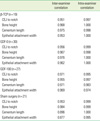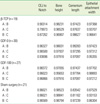1. Koo KT, Polimeni G, Albandar JM, Wikesjo UM. Periodontal repair in dogs: examiner reproducibility in the supraalveolar periodontal defect model. J Clin Periodontol. 2004. 31:439–442.

2. Hatakeyama Y, Uzel MI, Santana RB, Ruben MP. Relationship between position of probe tip and periodontal tissues after periodontal surgery in dogs. Int J Periodontics Restorative Dent. 2005. 25:247–255.
3. Armitage GC, Svanberg GK, Loe H. Microscopic evaluation of clinical measurements of connective tissue attachment levels. J Clin Periodontol. 1977. 4:173–190.

4. van der Velden U, de Vries JH. Introduction of a new periodontal probe: the pressure probe. J Clin Periodontol. 1978. 5:188–197.

5. Koo KT, Polimeni G, Qahash M, Kim CK, Wikesjo UM. Periodontal repair in dogs: guided tissue regeneration enhances bone formation in sites implanted with a coral-derived calcium carbonate biomaterial. J Clin Periodontol. 2005. 32:104–110.

6. Barnhart HX, Lokhnygina Y, Kosinski AS, Haber M. Comparison of concordance correlation coefficient and coefficient of individual agreement in assessing agreement. J Biopharm Stat. 2007. 17:721–738.

7. Quinn C, Haber MJ, Pan Y. Use of the concordance correlation coefficient when examining agreement in dyadic research. Nurs Res. 2009. 58:368–373.

8. Lee J, Tran Q, Seeba G, Wikesjo UM, Susin C. The criticalsize supraalveolar peri-implant defect model: reproducibility in histometric data acquisition of alveolar bone formation and osseointegration. J Clin Periodontol. 2009. 36:1067–1074.

9. Liao JJ, Lewis JW. A note on concordance correlation coefficient. PDA J Pharm Sci Technol. 2000. 54:23–26.
10. Barnhart HX, Haber M, Song J. Overall concordance correlation coefficient for evaluating agreement among multiple observers. Biometrics. 2002. 58:1020–1027.

11. Sculean A, Nikolidakis D, Schwarz F. Regeneration of periodontal tissues: combinations of barrier membranes and grafting materials-biological foundation and preclinical evidence: a systematic review. J Clin Periodontol. 2008. 35:106–116.

12. Kim CS, Choi SH, Chai JK, Cho KS, Moon IS, Wikesjo UM, et al. Periodontal repair in surgically created intrabony defects in dogs: influence of the number of bone walls on healing response. J Periodontol. 2004. 75:229–235.

13. Kim HY, Kim CS, Jhon GJ, Moon IS, Choi SH, Cho KS, et al. The effect of safflower seed extract on periodontal healing of 1-wall intrabony defects in beagle dogs. J Periodontol. 2002. 73:1457–1466.

14. Wikesjo UM, Hagen K, Nielsen DD. Periodontal repair in dogs: effect of saliva contamination of the root surface. J Periodontol. 1990. 61:559–563.

15. Wikesjo UM, Lim WH, Razi SS, Sigurdsson TJ, Lee MB, Tatakis DN, et al. Periodontal repair in dogs: a bioabsorbable calcium carbonate coral implant enhances space provision for alveolar bone regeneration in conjunction with guided tissue regeneration. J Periodontol. 2003. 74:957–964.

16. Wikesjo UM, Nilveus R. Periodontal repair in dogs: effect of wound stabilization on healing. J Periodontol. 1990. 61:719–724.

17. Shrout PE, Fleiss JL. Intraclass correlations: uses in assessing rater reliability. Psychol Bull. 1979. 86:420–428.

18. Jomha NM, Anoop PC, Elliott JA, Bagnall K, McGann LE. Validation and reproducibility of computerised cell-viability analysis of tissue slices. BMC Musculoskelet Disord. 2003. 4:5.

19. Barnhart HX, Song J, Haber MJ. Assessing intra, inter and total agreement with replicated readings. Stat Med. 2005. 24:1371–1384.

20. Barnhart HX, Haber MJ, Lin LI. An overview on assessing agreement with continuous measurements. J Biopharm Stat. 2007. 17:529–569.

21. Lin LI. A concordance correlation coefficient to evaluate reproducibility. Biometrics. 1989. 45:255–268.

22. Wang SF, Leknes KN, Zimmerman GJ, Sigurdsson TJ, Wikesjo UM, Selvig KA. Intra- and inter-examiner reproducibility in constant force probing. J Clin Periodontol. 1995. 22:918–922.

23. Shaoi J, Zhong B. Assessing the agreement between two quantitative assays with repeated measurements. J Biopharm Stat. 2004. 14:201–212.

24. Shultz SJ, Nguyen AD, Windley TC, Kulas AS, Botic TL, Beynnon BD. Intratester and intertester reliability of clinical measures of lower extremity anatomic characteristics: implications for multicenter studies. Clin J Sport Med. 2006. 16:155–161.

25. Kingman A, Albandar JM. Methodological aspects of epidemiological studies of periodontal diseases. Periodontol 2000. 2002. 29:11–30.





 PDF
PDF ePub
ePub Citation
Citation Print
Print








 XML Download
XML Download